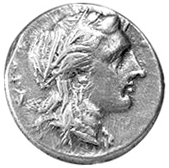...Best of Sicily presents... Best of Sicily Magazine. ... Dedicated to Sicilian art, culture, history, people, places and all things Sicilian. |
by Vincenzo Salerno | ||
Magazine Index Best of Sicily Arts & Culture Fashion Food & Wine History & Society About Us Travel Faqs Contact Map of Sicily |
Son of a potter, Agathocles moved to Syracuse around 343 BC and subsequently served in the army. Ten years later he married the widow of his wealthy patron. His ambition revealed itself early, and the Syracusans twice banished Agathocles from the city for his intrigues in attempting to overthrow their oligarchy, which had succeeded the remarkable Timoleon. He returned at the head of an army of mercenaries in 317 BC, ostensibly to restore democracy to the city. In fact, his conquering army massacred thousands of people, mostly civilians, and banished thousands more. As tyrant of Syracuse, he was absolute ruler of the city and its environs; the term "tyrant" (from the Greek tyros) did not then carry the negative overtures it does today, though it did imply absolute rule by a single individual. Sicily's Greek cities were frequently at war with the Carthaginians in a series of conflicts which may be viewed as a kind of prelude to the subsequent Punic Wars between Carthage and Rome over a century later, and Agathocles was defeated in 311 BC at the Battle of Himera, near the town of his birth. Seeking to destroy Carthaginian influence at its source, he invaded northern Africa in 310, and a truce was signed four years later. In 304 he decided to take the title "king" of Sicily, a title which actually reflected the dominance of Syracuse over its major Sicilian rivals Akragas (Agrigento), Selinus (Selinunte) and Segesta. In fact, the treaty with the Carthaginians only guaranteed his territorial authority over the region to the east of the Halycus (Platani) river; though it recognised his nominal authority over all the Greek cities, the Carthaginians retained commercial control of several ports (most importantly Motya, Soluntus, Palermo, Erice) in western Sicily. Agathocles' new title was, in many ways, an empty one. Sicily's Greeks still did not consider themselves Sicilians so much as citizens of their own cities. He died in 289 BC. In old age and ailing health, Agathocles had a number of enemies, including his grandson, Arkagathos, who is reputed to have poisoned him, though Maenon is more often mentioned in this connection. Yet in his later years Agathocles restored democracy to Syracuse and achieved a certain popularity. He wanted his successor to be elected rather than appointed, and was succeeded by Hicetas, whose challenge was a period of internal military strife involving the Carthaginians and Neapolitan mercenaries known as Mammertines. Pyrrhus of Epirus, who was married to Lanassa, daughter of Agathocles, later jumped into the political fray. Timaeus, who was exiled by Agathocles, was perhaps his most vehement critic, though this bias should be considered objectively. Machiavelli's description of Agathocles as one of "those who by their crimes become princes" should also be viewed in an impartial light. Some of our knowledge of this period comes to us from Diodorus Siculus who, however, wrote long after these events took place. About the Author: Palermo native Vincenzo Salerno has written biographies of several famous Sicilians, including Frederick II and Giuseppe di Lampedusa. | |
Top of Page |
 In the annals of ancient
In the annals of ancient